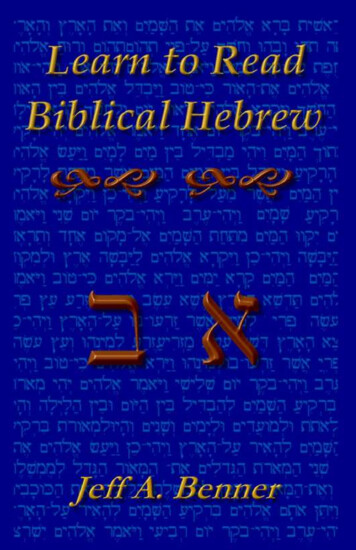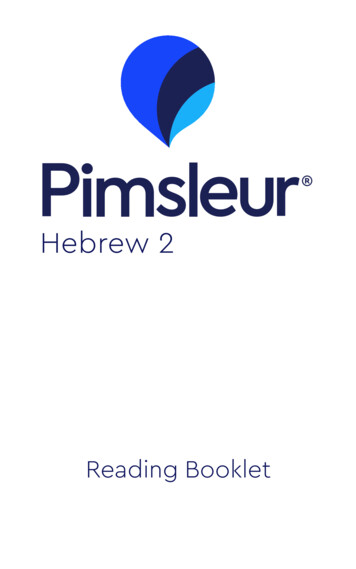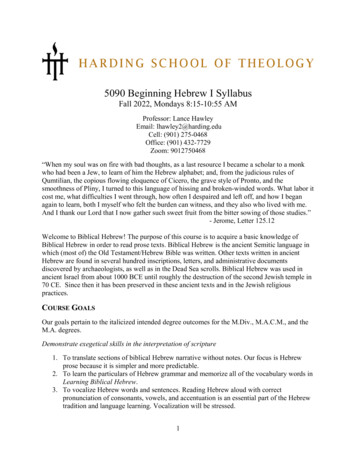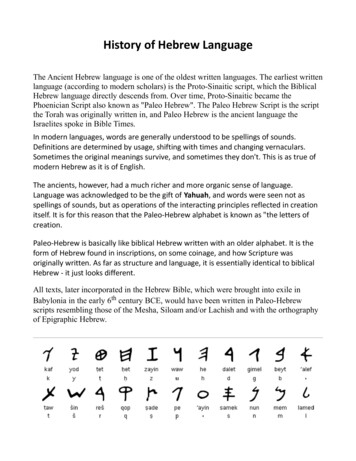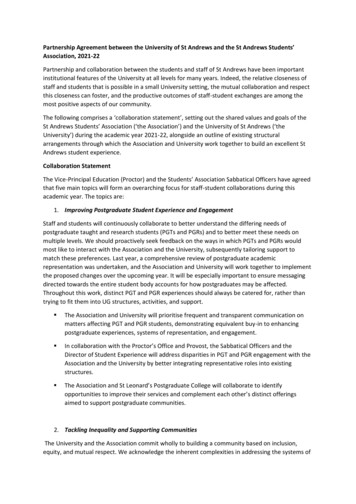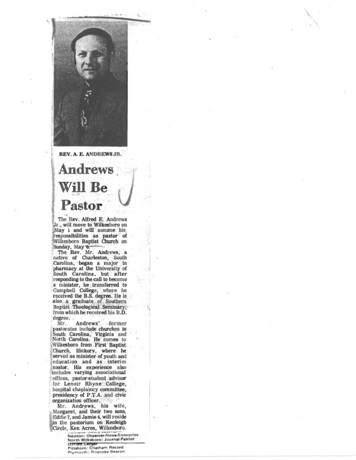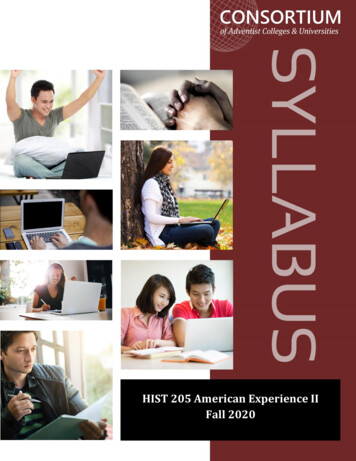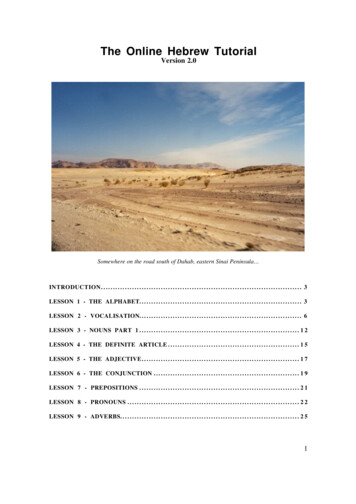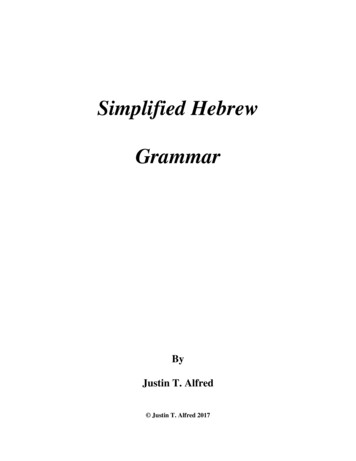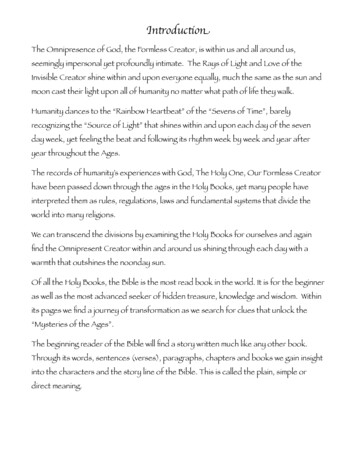
Transcription
Hebrew Placement ExaminationI.RequirementAll incoming M.Div. students are required to take a two-hour (maximum) placementexamination in biblical Hebrew. The examination is given on a pass/fail basis four times peryear: as the final exam for OTST552 Biblical Hebrew II (Spring Semester); the Friday priorto the beginning of Summer Semester; during M.Div. orientation week before the AutumnSemester begins; and toward the end of Autumn Semester. Failure to take the examinationwithin the first year of M.Div. study constitutes failure of the examination. Passing theexamination or OTST552 Biblical Hebrew II with a C or higher is required for admission toa number of Old Testament exegesis classes.II.ProficiencyThe examination assesses proficiency in translation, morphology, and syntax of biblicalHebrew. Depending on their score, those who fail the examination are required to takeeither the OTST551 Biblical Hebrew I or OTST552 Biblical Hebrew II.III.PreparationVocabulary:Students need to know Hebrew words that occur in the Old Testament 100 ormore times.Morphology: Students need a working knowledge of basic Hebrew grammar, including theparadigms of the regular/strong verb of the seven basic verbal patterns (Qal,Nifal, Piel, Pual, Hifil, Hofal, and Hithpael), and ability to recognize the weakpatterns, as well as knowledge of the personal pronouns and pronominalsuffixes.Syntax:Students need a working knowledge of basic Hebrew syntax, includingrecognition of emphatic and disjunctive word order, dependent clauses, andrelationships between clauses as conditioned by verbal tense/aspect.IV.Review SessionThe Old Testament Department will offer an optional intensive review session the week priorto the MDiv orientation week in August. This session, concentrating on morphology andsyntax, will be designed to assist students in their preparation for the exam.V.Examination FormatThe qualifying examination consists of 40 multiple choice questions. The first part of theexam covers vocabulary (word frequency of 100x and above) and basic morphology. Thesecond part, for which a Hebrew dictionary/lexicon is permitted, covers translation,grammar, and syntax of one or more short biblical narrative passages which will beprovided. The student may use any of the standard Hebrew lexicons; such as: Brown, F., S.R. Driver, and C. A. Briggs, A Hebrew and English Lexicon of the Old Testament; William L.Holladay, A Concise Hebrew and Aramaic Lexicon of the Old Testament; and LudwigKoehler, Ludwig, Walter Baumgartner, and Johann J. Stamm, Hebrew and AramaicLexicon of the Old Testament. No electronic or analytical lexicons may be used.VI.Sample Examination and AnswersSee the attached sample examination. The answers for the examination are as follows:1. B5. B9. C13. C17. A21. A25. D29. A33. D37. A2. D6. D10. A14. A18. C22. D26. B30. C34. B38. C3. A7. A11. C15. B19. D23. B27. B31. C35. C39. B4. B8. B12. D16. B20. D24. A28. D32. B36. D40. C1
VII.Hebrew Tutorial Web SiteFor those who have an Andrews University e-mail address, you may access the HebrewTutorial at www.andrews.edu/SEM/semtech/HebrewTutorial.VIII. Sources for StudyA. Hebrew BibleBiblia Hebraica Stuttgartensia. 4th Edition. Stuttgart: Deutsche Bibelgeselschaft,1990.B. Hebrew Tutor Multimedia CD-Rom by Parson Technology. Available through ChristianBook (www.christianbook.com; phone: 1.800.247.4784).C. Vocabulary and Lexicons1. Mitchell, Larry A. A Student's Vocabulary for Biblical Hebrew and Aramaic. GrandRapids, MI: Zondervan Publishing House, 1984.2. Brown, F., S. R. Driver, and C. A. Briggs. A Hebrew and English Lexicon of the OldTestament. Peabody, MS: Hendrickson Publishers, 1996.3. Holladay, William L. A Concise Hebrew and Aramaic Lexicon of the Old Testament.Grand Rapids, MI: William B. Eerdmans Publishing Company, 1988.4. Koehler, Ludwig, Walter Baumgartner, and Johann J. Stamm. The Hebrew andAramaic Lexicon of the Old Testament (2 vols.). Trans. and ed. M. E. J. Richardgon.New York: E. J. Brill, 2002.D. Useful Grammars1. Doukhan, B. Jacques. Hebrew For Theologians: A Textbook for the Study ofBiblical Hebrew in Relation to Hebrew Thinking. Lanham, MD: University Press ofAmerica, 1993.2. Kelley, Page H. Biblical Hebrew: An Introductory Grammar. Grand Rapids, MI:William B. Eerdmans Publishing Company, 1992.3. Kelley, Page H., Terry L. Burden, and Timothy G. Crawford. A Handbook to theBiblical Hebrew. Grand Rapids, MI: William B. Eerdmans Publishing Company,1994.4. Seow, Choon-Leong. A Grammar for Biblical Hebrew. Revised Edition. Nashville,TN: Abingdon Press, 1995.5. Weingreen, J. A Practical Grammar for Classical Hebrew. Oxford: OxfordUniversity Press, 1959.6. Williams, Ronald E. Hebrew Syntax: An Outline. 2nd Edition. Toronto: Universityof Toronto Press, 1976.7. Waltke, Bruce K., and M. O'Conor. An Introduction to Biblical Syntax. WinonaLake, IN: Eisenbrauns, 1990.E. ConcordanceEven-Shoshan, Abraham. A New Concordance of the Old Testament. Grand Rapids,MI: Baker Book House, 1993.F. Old Testament Text and Critical Apparatus1. Wurthwein, Ernst. The Text of the Old Testament. 2nd Edition. Grand Rapids, MI:William B. Eerdmans Publishing Company, 1995.2. Wonneberger, Reinhard. Understanding BHS: A Manual for the Users of BHS. 2ndEdition. Rome: Editrice Pontificio Instituto Biblico, 1990.3. Kelley, Page H., Daniel S. Mynatt, and Timothy G. Crawford. The Masorah of BibliaHebraica Stuttgartensia: Introduction and Annotated Glossary. Grand Rapids, MI:William B. Eerdmans Publishing Company, 1998.4. Brotzman, Ellis R. Old Testament, Textual Criticism: A Practical Introduction.Grand Rapids, MI: Baker Book House, 1994.2
Grammatical Terms You Need to KnowIntermediate Hebrew II LevelGrammatical TermMeaningClauseContains at least one verb, explicit or understoodMain ClauseThe primary thoughtIndependent ClauseStands alone as a complete thoughtDependent ClauseDependent upon the main clause for meaningSubordinate ClauseDependent upon the main clause for meaning, because, forRelative ClauseIntroduced by which/thatMotive ClauseIntroduced by forVerbal ClauseContains a verbNominal ClauseVerb is understoodConstruct ChainGenitival relationship, ofPrepositional PhraseIntroduced by a preposition:AntecedentThat to which the pronoun refersAppositionRestates the same thing in different words: my father, the doctor; givesadditional infoAccompanimentShe sat down, and her daughtersComplimentTells you something extra: my father is the doctor; whatcomes after the verb “to be”DisjunctiveI am happy, but you are sadConjunctiveI am happy and you are happyEmphatic Word OrderI will surely live Lit.: Living, I will liveCognateSame word root used twice for emphasis or clarificationCircumstantialIf . than; when or while something is going onGentilicPeople groups, American, IsraeliteGenitivalExpresses possession ofParentheticalParenthesis; can be a whole sentence giving additional information about asituationResumptiveReturn to a previous thought; picks up a previous train of thought3
4
Hebrew Placement Examination 6Theological Seminary, Andrews UniversityI. VocabularyChoose the best definition for each of the following words.1.rRvSaa. do, makeb. whoc. placed. ash2.hDkÎna.b.c.d.3.strangertelllift upbe hitMD;da. bloodb. dumbc. perfectd. sea4.NAoAmVla. to answerb. for the sake ofc. at the appointed timed. why?5.N‰zOaa.b.c.d.6.thenearstrengthdoinglAjÅn1
a.b.c.d.7.be sickcomfortassemblytorrent valleyrAtÎya. be left, remainb. be goodc. permitd. turnII. Verb MorphologyChoose the best answer to each of the following questions.8. What are the parsing and root ofyIcSoA;tÅw?a. Qal imperfect consecutive/conversive first person common singular of cwob. Qal imperfect consecutive/conversive second person feminine singular of hcoc. Piel perfect consecutive/conversive first person common singular of cotd. Hiphil imperfect consecutive/conversive second person feminine plural of coy9. What is the parsing of lE;låq in lE;låqVl ?a. Qal perfect third person masculine singularb. Piel participle masculine singularc. Piel infinitive constructd. Hiphil infinitive absolute10. What are the parsing and root of wm wq ?a. Qal imperative second person masculine plural of Mwqb. Qal imperfect third person common plural of Mwqc. Pual perfect first person common plural of hmqd. Hophal perfect third person common plural of Mqn11. What is the parsing oftwøaDlVpˆn ?a. Qal imperfect first person common pluralb. Qal participle feminine singular2
c. Niphal participle feminine plurald. Piel imperfect first person common plural12. What is the parsing of yˆnA;tVkAlVmIh ?a. definite article Qal perfect second person feminine singularb. Niphal perfect first person common singularc. Piel imperfect third person masculine singular pronominal suffix first person commonplurald. Hiphil perfect second person masculine singular pronominal suffix first personcommon singular13. What is the parsing of MEjÅnVtIm ?a.b.c.d.Niphal participle masculine singularHithpael perfect third person feminine singularHithpael participle masculine singularHithpael imperative second person maculine plural14. What is the parsing of hÎn rAbDÚvI;t ?a. Niphal imperfect third person feminine pluralb. Piel imperfect second person masculine pluralc. Hiphil imperfect third person feminine singulard. Hithpael infinitive construct plus third person feminine singular pronominalsuffix15. Which of the following is a Pual imperfect third person masculine singular ?hDlDÚvU;brA;kUb yc. JKwølDhd. dAmFoÎya.b.3
III. TextChoose the best answer to each of the following questions. You may use a lexicon forthis section only.Text AhDl yA;lAh tOa rAmV;b lEa rVcˆyVl MyIhølTa rRmaø yÅw verse 1yˆnE nIh rRmaø yÅw bOqSoÅy bOqSoÅy rRmaø yÅwhDm yårVxIm h d rEm a ryI;t lAa ÔKyIbDa yEhølTa lEaDh yIkOnDa rRmaø yÅw verse 2MDv ÔKVmyIcSa lwødÎ g ywøgVl yI;khølDo MÅg ÔKVlAoAa yIkOnDa w hDm yårVxIm ÔKV;mIo dérEa yIkOnDa verse 3ÔKy‰nyEo lAo wødÎy tyIvÎy PEswøy w16. What is the syntactic relationship between tOa rAm and hDl yA;lAh (verse 1)?a.b.c.d.appositionconstructprepositional phrasesubject and indirect object17. Which of the following best describes yˆnE nIhrRmaø yÅw bOqSoÅy bOqSoÅy rRmaø yÅw (verse 1)?a. call and responseb. question and answerc. command and fulfillmentd. event and previous background information18. What kind of clause is KyIbDaa.b.c.d.yEhølTa lEaDh yIkOnDa (verse 2)?dependentmotivenominal/verblessrelative19. What is the root of a ryI;t (verse 2)?a.b.c.artarnawr4
d.ary20. What is the function of h in hDm yårVxIm (verse 2) ?a.b.c.d.ending of feminine singular verbthird person feminine singular suffixa root letter of the wordindicates direction21. What is the best translation of MDvÔKVmyIcSa lwødgÎ ywøgVl yI;k(verse 2)?a. "for I will make you a great nation there."b. "but for a people of greatness I will set your name."c. "for I made your name into a great nation."d. "for I will cast a lot for your nation there."22. In hDm yårVxImÔKV;mIo dérEa yIkOnDa what is the function of yIkOnDa (verse 3) ?a. subjectb. indirect objectc. emphaticd. both answers a. and c.23. What are the parsing and root of dérEa (verse 3)?a. Qal perfect third person masculine singular of drab. Qal imperfect first person common singular of dryc. Niphal imperfect first person common singular of hdrd. Hophil imperfect first person common singular of ddr24. What is the antecedent of wø in wødÎy (verse 3)?a.b.c.d.JosephJacob/IsraelGodEgyptText B5
oår‰ΩzAh NIm h d whyIl rDmDt h dVlÎy rRvSa X rRÚp tyEbV;k ÔKVtyEb yIhyˆw verse1taøΩzAh h rSoÅ nAh NIm ÔKVl hÎwh y NE;tˆy rRvSaNwøy rEh ;hDl hÎwh y NE;tˆ yÅw DhyRlEa aøbÎ yÅw hDÚvIaVl wøl yIh;tV Åw t wr tRa zAoO;b jå;qˆ yÅw verse 2NE;b dRlE;tÅwlEaø g JKDl tyI;bVvIh aøl rRvSa hÎwh y JK wrD;b yImFoÎn lRa MyIvÎ nAh hÎn rAmaø;tÅw verse3lEa rVcˆyV;b wømVv aér ;qˆy w Mwø yAh25. What is the best translation of h d whyIl(verse 1)?a.b.c.d."and your house was breached like the house which Tamar bore to Judah""and your honorable house, Perez, whom Tamar will bear to Judah""and may Tamar's house be like your house, as Perez was born to Judah""and may your house be like the house of Perez, whom Tamar bore to Judah"26. What kind of clause is taøΩzAha.b.c.d.h rSoÅ nAh NIm ÔKVl hÎwh y NE;tˆy rRvSa (verse 1)?motiverelativenominal/verblessinterrogative27. In t wr tRaa.b.c.d.rDmDt h dVlÎy rRvSa X rRÚp tyEbV;k ÔKVtyEb yIhyˆwzAoO;b jå;qˆ yÅwwhat is the syntactic function of t wr (verse 2)?subjectdirect objectindirect objectobject of preposition28. What is ;h in ;hDl (verse 2)?a.b.c.d.indirect objectobject of prepositionpronominal suffixall of the above answers29. What is the parsing ofhÎn rAmaø;tÅw(verse 3)?a. Qal imperfect consecutive/conversive third person feminine pluralb. Qal imperfect second person masculine singular pronominal suffix first personcommon plural6
c. Qal imperfect third person feminine singular pronominal suffix third personfeminine singulard. Hithpael perfect first person common plural30. What is the parsing of JK wrD;b (verse 3)?a.b.c.d.Qal imperative second person masculine singularpreposition Qal infinitive absoluteQal passive participle masculine singularit is a noun31. What is the best translation of Mwø yAhlEaø g JKDl tyI;bVvIh aøl rRvSa (verse 3)?a. "because you have not ceased to redeem the day"b. "who has redeemed you this day"c. "who has not let a kinsman be lacking for you today"d. "which he has ceased for himself to be a kinsman for you today"32. Why is there a dagesh in the q of aér ;qˆy w (verse 3)?a.b.c.d.assimilation of a root letterassimilation in a Niphal formdoubling in a Piel formdoubling in a Pual form33. What is wømVv (verse 3)?a.b.c.d.verb pronominal suffix third person masculine singularrelative pronoun pronominal suffix third person common pluralproper noun (name of a person)noun pronominal suffix third person masculine singularText Ct wkVlA;mAh yIxSj dAo JKEtDv ;qA;b hAm w hD;kVlA;mAh rE;tVsRa JKD;l hAm JKRlmR; Ah ;hDl rRmaø yÅw verse 1JKDl NEtÎ nˆy whR;tVvI;mAh lRa Mwø yAh NDmDh w JKRlR;mAh awøbÎy bwøf KRlR;mAh lAo MIa rE;tVsRa rRmaø;tÅw verse 2wøl yItyIcDo rRvSaJKRlR;mAh aøbÎ yÅw rE;tVsRa rAb ;d tRa twøcSoAl NDmDh tRa wrShAm JKRlR;mAh rRmaø yÅw verse 3rE;tVsRa hDtVcDo rRvSa hR;tVvI;mAh lRa NDmDh w7
34. What kind of expression is introduced in verse 1 by hAm ?a.b.c.d.an assertiona questiona deniala command35. What kind of expression is JKDla. an explanationb. a questionc. a promised. a commandNEtÎ nˆy w t wkVlA;mAh yIxSj dAo (verse 1)?36. What is the best translation of:wøl yItyIcDo rRvSa hR;tVvI;mAh lRa Mwø yAh NDmDh w JKRlR;mAh awøbÎy(verse 2)?a. "the king and Haman came today to a banquet which she had prepared for them"b. "if the king and Haman will come today to the banquet which Esther will preparefor Haman"c. "the king and Haman went out on the day of the banquet which she waspreparing"d. "let the king and Haman come today to the banquet that I have prepared for him"37. How do you explain the first yod (in the middle) of yItyIcDo (verse 2)?a. Lamed-He (final h) rootb. Middle Gutteral rootc. Hiphil formd. Usual part of suffix in a perfect form38. How do you explain the h\atef-pat\ah\ under the h of wrShAm (verse 3)?a. part of the paradigm of the strong verbb. Initial Gutteral rootc. Middle Gutteral rootd. shortening before pronominal suffix39. What is the best translation of twøcSoAl (verse 3)?a.b.c.d."do!""to do""they (feminine plural) were doing""to be done"8
40. When does the action described by aøbÎ yÅw occur in relation to the action described byhDtVcDo (verse 3)?a.aøbÎ yÅw happens before hDtVcDo.aøbÎ yÅw and hDtVcDo happen at the same time.hDtVcDo happens before aøbÎ yÅw.b.c.d. In this context it is not possible to know which happens first.9
second part, for which a Hebrew dictionary/lexicon is permitted, covers translation, grammar, and syntax of one or more short bib


